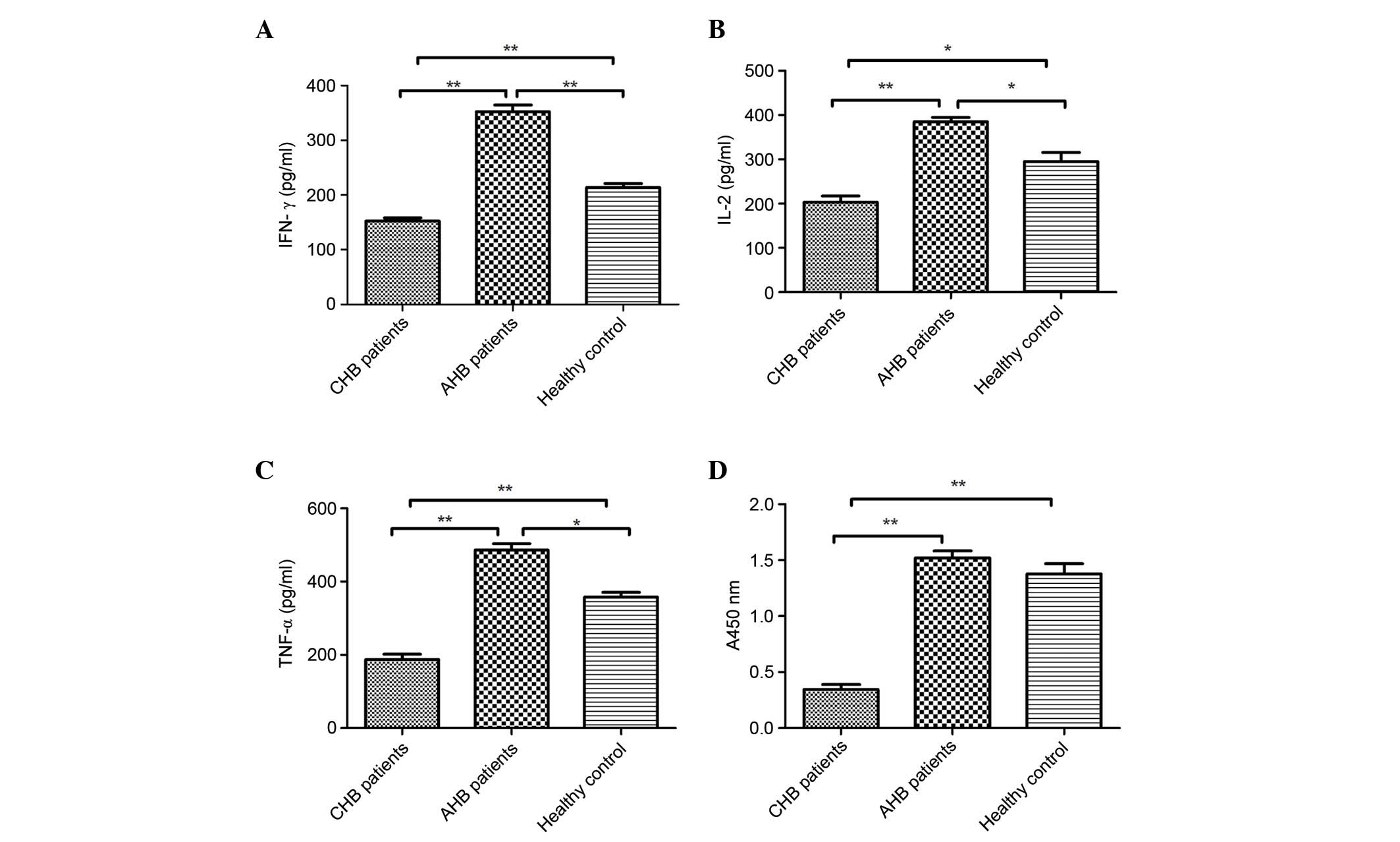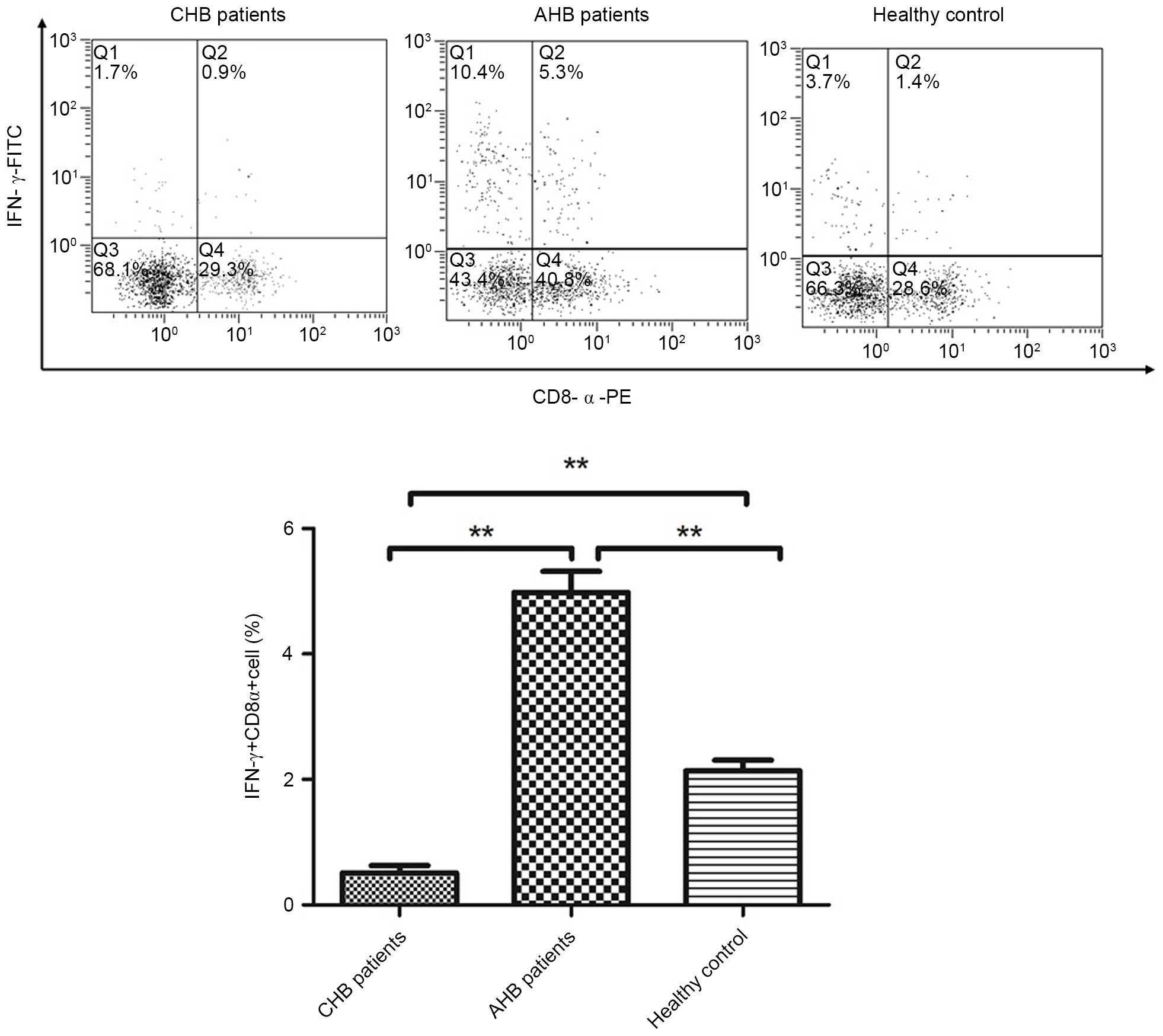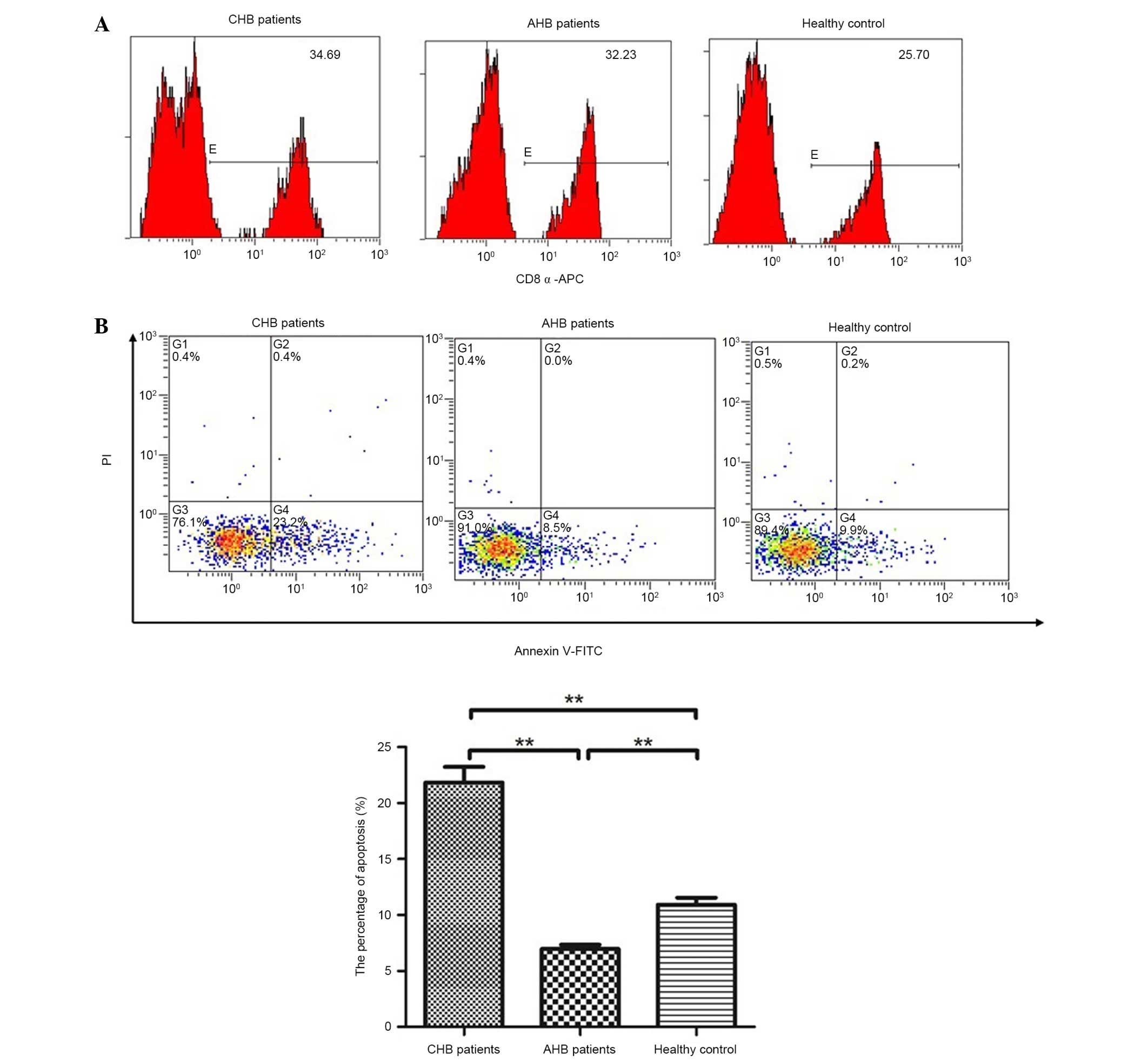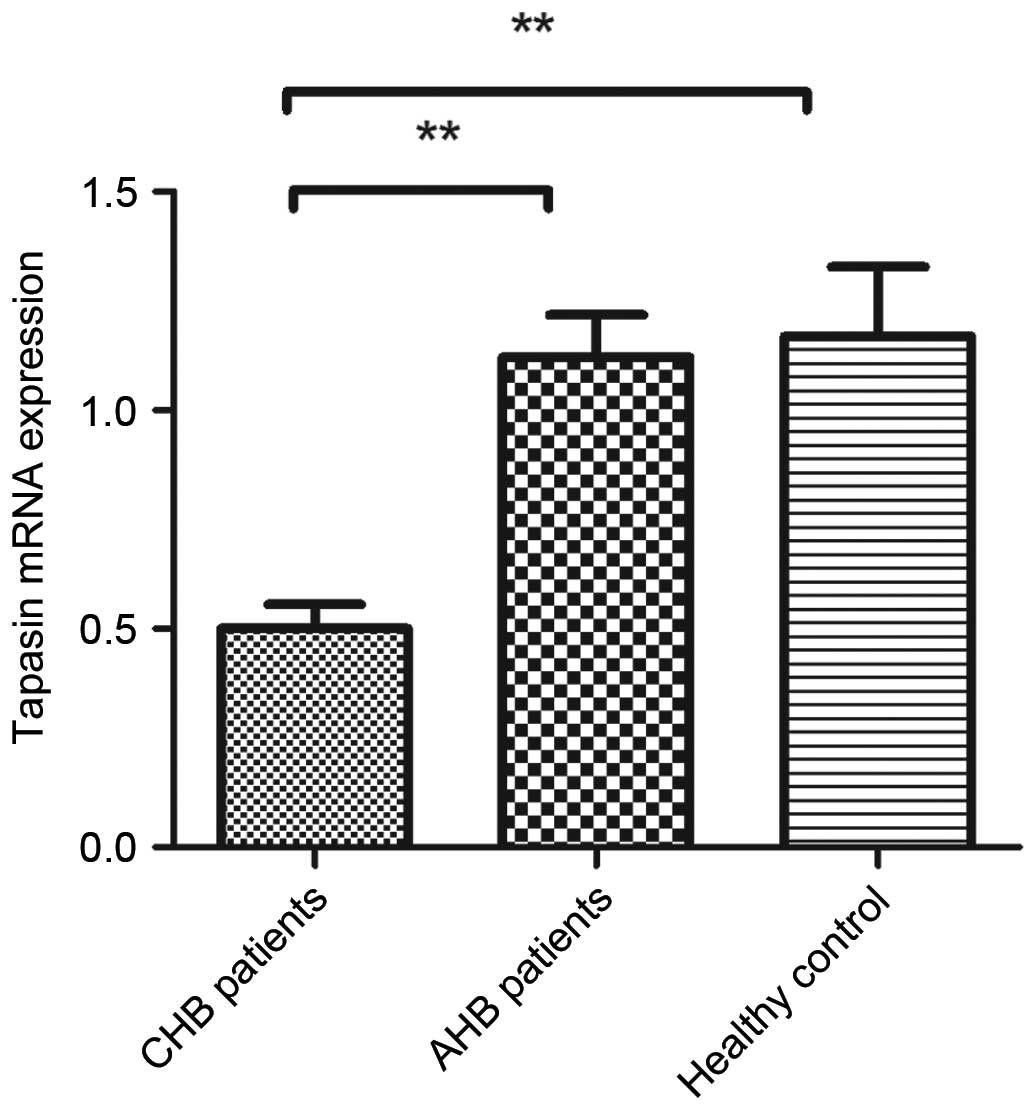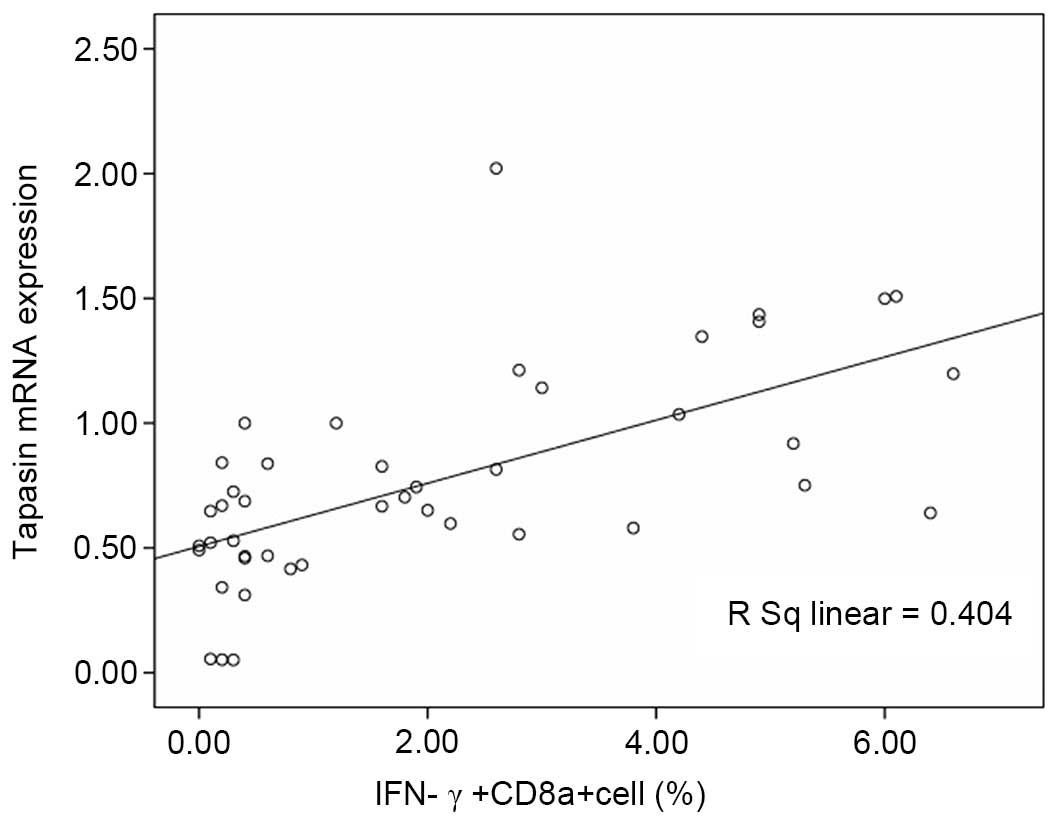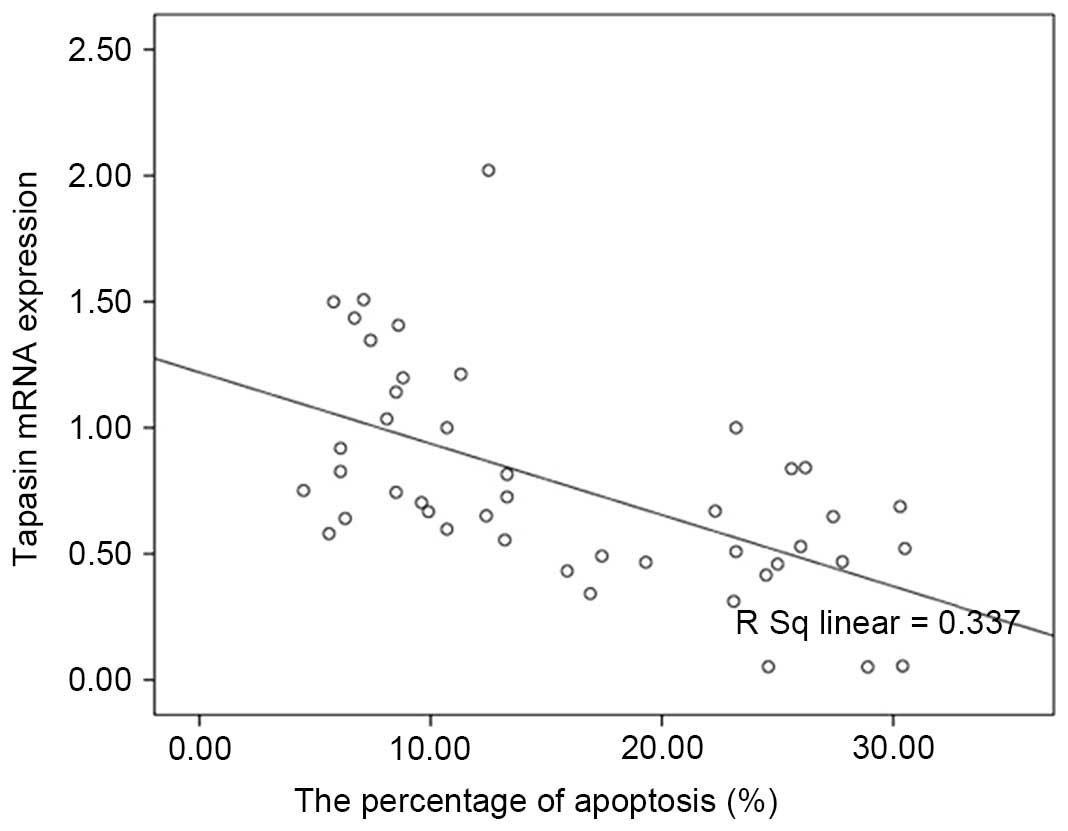Correlation between low tapasin expression and impaired CD8+ T‑cell function in patients with chronic hepatitis B
- Authors:
- Published online on: August 9, 2016 https://doi.org/10.3892/mmr.2016.5610
- Pages: 3315-3322
Abstract
Introduction
Chronic hepatitis B virus (HBV) infection is caused by a complex interaction between a replicating noncytopathic virus and aberrant host antiviral immunity (1,2). Persistent infection causes chronic liver cell injury, regeneration, inflammation, widespread DNA damage and insertional dysregulation of cellular growth control genes. These factors consequently result in the development of cirrhosis and hepatocellular carcinoma (3,4). Persistent HBV infection is characterized by a weak adaptive immune response, which is presumed to be due to insufficient CD4+ T-cell priming early in the infection, and the subsequent development of an ineffective CD8+ T-cell response (5,6).
Virus-specific CD8+ T cells are able to efficiently control HBV replication predominantly by noncytolytic mechanisms, and this effect is mediated by the secretion of interferon (IFN)-γ and tumor necrosis factor (TNF)-α cytokines, thus limiting viral spread to uninfected cells and reducing the degree of immunopathology required to clear the infection (3,7). Virus-infected cells, or cells that have undergone malignant transformation, are eliminated by cytotoxic T lymphocytes (CTLs), which recognize antigenic peptide epitopes in complex with major histocompatibility complex class I (MHC I) molecules at the cell surface (7). The majority of these peptides are derived via proteasomal degradation in the cytosol, and are subsequently translocated into the lumen of endoplasmic reticulum (ER) in an energy-consuming manner by the transporter associated with antigen processing (TAP), which delivers peptides onto MHC I molecules as final acceptors. Previous studies have suggested that the molecular chaperone tapasin, which mediates the binding of TAP, stabilizes peptide-receptive MHC I conformation by facilitating peptide exchange and allowing more peptides to be translocated into the ER, thus enhancing specific MHC class I-restricted CTL activity (8,9). The loading of antigen-derived peptides onto MHC class I molecules for presentation to CTLs is a key process in the adaptive immune response, which has an important role in HBV clearance (9).
Our previous study demonstrated that the expressed and purified fusion protein cytoplasmic transduction peptide (CTP)-HBV core antigen (HBcAg)18–27-Tapasin could enter the cytoplasm of bone marrow-derived dendritic cells (BMDCs), promoting BMDC maturation and efficiently enhancing the T-cell immune response in vitro (1). Furthermore, the CTP-HBcAg18–27-Tapasin fusion protein could enhance the percentage of CTLs, induce robust specific CTL activity, reduce apoptosis of CD8+ T cells and inhibit HBV replication in vivo (10,11). It has also been demonstrated that chronic HBV (CHB) infection is associated with reduced antigen-presenting capacity and insufficient CTL production (12). The molecular chaperone tapasin, which mediates binding of TAP, has an important role in endogenous antigen processing and presentation, and is able to induce specific CTL responses (13). The present study aimed to determine whether tapasin is associated with CHB infection. The present study investigated whether tapasin mRNA expression was correlated with impaired CD8+ T-cell function in peripheral blood mononuclear cells (PBMCs) from patients with CHB.
Materials and methods
Reagents and antibodies
The anti-CD8α (cat. nos. 11-0086 and 17-0086) and IFN-γ (cat. no. 11-4724) fluorescent antibodies and corresponding isotype controls (cat. nos. 17-4724, 12-4714 and 11-4724) were obtained from eBioscience, Inc. (San Diego, CA, USA). The Annexin V-fluorescein isothiocyanate (FITC) Apoptosis Detection kit was purchased from Invitrogen (Thermo Fisher Scientific, Inc., Waltham, MA, USA). Enzyme-linked immunosorbent assay (ELISA) kits for IFN-γ, TNF-α and interleukin (IL)-2 were obtained from R&D Systems, Inc. (Minneapolis, MN, USA). Ionomycin, monensin and phorbol 12-myristate 13-acetate (PMA) were purchased from Sigma-Aldrich (Merck Millipore, Darmstadt, Germany).
Patients
Peripheral heparinized blood samples were obtained from patients with CHB infection (n=27) and acute HBV infection (AHB; n=20). All patients were positive for HBV surface antigen (HBsAg) and HBV envelope antigen. All patients were confirmed to be negative for other viral infections, including hepatitis C, hepatitis D and human immunodeficiency virus. The presence of other liver diseases, including alcoholic, metabolic or autoimmune hepatitis, was ruled out. Patients had not received any antiviral treatment or immunotherapy for 6 months prior to blood collection. Healthy controls (n=26) (age-, gender- and race-matched) had no evidence of prior exposure to HBV (HBsAg-negative). All donors provided written informed consent. The clinical characteristics of the patients are listed in Table I. Experiments and procedures were conducted in accordance with the Helsinki Declaration of 1975, and were approved by the Human Ethics Committee of Shanghai Jiaotong University, School of Medicine (Shanghai, China).
Cell isolation
PBMCs were obtained from fresh heparinized blood by Ficolle Isopaque gradient centrifugation. Briefly, peripheral venous blood (10 ml) samples were collected from patients in a heparinized test tube. The entire blood sample was diluted to a final volume of 20 ml in phosphate-buffered saline (PBS). The suspension was then poured into 10 ml Ficoll-Biocoll separating solution (Dakewe Biotech Co., Ltd., Beijing, China) in a conical tube. Following density gradient centrifugation (1,007.1 × g, 20°C, 20 min), PBMCs were isolated. The isolated cells were carefully collected and washed twice with sterile PBS (566.5 × g, 20°C, 10 min,) and re-suspended in RPMI-1640 (Gibco, Thermo Fisher Scientific, Inc., Waltham, MA, USA). Cell viability was determined by trypan blue staining and cells were counted; cell viability should always be >95%. The final cell density was adjusted to 5-6×106 cells/ml. PBMCs from healthy volunteers were isolated in the same manner. Furthermore, serum samples were obtained from 5 ml blood, which was centrifuged for 5 mins at 2,389.5 × g to obtain ~2 ml plasma. The samples were added to a 24-well culture plate and maintained at −20°C for subsequent experiments.
Cytokine level measurement
The serum concentrations of IFN-γ, IL-2 and TNF-α were detected by Quantikine ELISA kits (DTA00C, DIF50 and D2050; R&D Systems) according to the manufacturer's protocols. The cytokine concentrations in the samples were determined from standard curves. Data are expressed as pg/ml.
Lymphocyte proliferation activity assay
The PBMCs (1×106 cells/ml) were cultured in 96-well culture plates at a final volume of 100 µl in the presence of 5 µg/ml phytohemagglutinin (PHA) solution at 37°C, in an atmosphere containing 5% CO2, for 48 h. Subsequently, 10 µl Cell Counting kit-8 solution (Beyotime Institute of Biotechnology, Haimen, China) was added to the plates at 37°C in an atmosphere containing 5% CO2 for 4 h (14). Absorbance was finally measured at a wavelength of 450 nm.
Assessment of apoptosis ex vivo
As aforementioned, PBMCs (1×106 cells/ml) were cultured in 6-well plates at 37°C. After washing with PBS, cells were stained with saturating concentrations of allophycocyanin-conjugated anti-CD8α McAb (cat. no. 17-0086) and isotype control (cat. no. 17-4724) for 15 min. Annexin V-FITC and propidium iodide staining (Invitrogen; Thermo Fisher Scientific, Inc.) was then conducted according to the manufacturer's protocol, except that all staining was performed on ice. The percentage of cells highly stained with Annexin V among the antigen-specific CD8+ T cells was determined by flow cytometry. Fluorescence analyses were performed on a COULTER EPICS XL Flow Cytometer (Beckman Coulter, Inc., Brea, CA, USA) using Expo32-ADC software.
Intracellular staining for IFN-γ
To evaluate the percentage of IFN-γ-secreting cells in the CD8+ T-cell population from PBMC samples, single cell (1×106 cells/ml) suspensions were analyzed by flow cytometry. PBMCs were stimulated in the presence of 10 µg/ml HBcAg for 6 h. After incubation for 3 h, 1 µg/ml ionomycin, 25 µg/ml PMA and 1.7 µg/ml monensin (Sigma-Aldrich; Merck Millipore) were added and the cells were incubated for a further 3 h (15). After washing with PBS, cells were stained with phycoerythrin-labeled anti-CD8α McAb (cat. no. 11-0086) and isotype control (cat. no. 11-4724) for 15 min. The cells were then fixed with Fix and Perm reagent A and B (BD Biosciences) and were incubated for 30 min with saturating concentrations of FITC-conjugated anti-IFN-γ McAb (cat. no. 12-7319; eBioscience, Inc.). Subsequently, the cells were washed twice with PBS and were analyzed by flow cytometry. Fluorescence analyses were performed on a COULTER EPICS XL Flow Cytometer using Expo32-ADC software 1.0 (Beckman Coulter, Brea, CA, USA).
RNA and cDNA preparation from PBMCs
Peripheral blood was collected in sodium citrate-containing cell preparation tubes. PBMCs were separated by density gradient centrifugation. Subsequently, total RNA was extracted from the PBMCs (5×105) using TRIzol® (Invitrogen; Thermo Fisher Scientific, Inc,) and was treated with RNase-free DNase (Qiagen GmbH, Hilden, Germany) to remove genomic DNA contamination. RNA (1 µg) was reverse transcribed to cDNA using a reverse transcription (RT) system kit (Promega Corporation, Madison, WI, USA), according to the manufacturer's instructions.
Quantitative polymerase chain reaction (qPCR)
qPCR was performed using SYBR® Premix Ex Taq reagents (Takara Bio Inc., Otsu, Japan) on a LightCycler (Roche Diagnostics, Basel, Switzerland). Glyceraldehyde 3-phosphate dehydrogenase (GAPDH) was used as an internal reference. Primers were designed by Primer Premier 5.0 (Premier Biosoft, Palo Alto, CA, USA) according to the mRNA sequences of tapasin retrieved from GenBank (http://www.ncbi.nlm.nih.gov/genbank/), and were synthesized by Sangon Biotech Co., Ltd. (Shanghai, China). The PCR primer sequences were as follows: Tapasin, forward 5′-GAGTGTTGGTTCGTGGAGGAT-3′, reverse, 5′-TGGCTGTGGTCGCAAGAGG-3′; and GAPDH, forward 5′-ATGGGGAAGGTGAAGGTCG-3′ and reverse 5′-GGGGTCATTGATGGCAACAATA-3′. The PCR cycling conditions were as follows: 30 sec at 95°C followed by 40 cycles of 95°C for 5 sec and 60°C for 30 sec, and a final step of 95°C for 15 sec, 60°C for 1 min and 95°C for 15 sec. The expression levels of the target gene were calculated using the 2−ΔΔCq method (16). Three parallel reactions of each sample and internal controls were run.
Statistical analysis
Data are presented as the mean ± standard error of the mean and were analyzed by SPSS 16.0 software (SPSS Inc., Chicago, IL, USA). One-way analysis of variance and post-hoc least significant difference test were used to determine the statistical significance in comparison to the control. The linear regression and bivariate correlation tests were used to analyze correlations among the groups. P<0.05 was considered to indicate a statistically significant difference.
Results
Cytokine serum levels (IFN-γ, IL-2 and TNF-α) and lymphocyte proliferative activity
The inability of CD8+ T cells to produce three cytokines is a hallmark of functional exhaustion (17,18). Therefore, the present study analyzed the levels of the following cytokines: IFN-γ, IL-2 and TNF-α in the serum of all groups. As shown in Fig. 1A–C, IFN-γ (152.63±5.43 pg/ml), TNF-α (187.12±14.68 pg/ml) and IL-2 (202.84±14.41 pg/ml) levels were significantly lower in the serum of patients with CHB compared with in those with AHB (IFN-γ, 352.64±12.03 pg/ml; TNF-α, 485.91±17.45 pg/ml; and IL-2, 384.73±10.17 pg/ml) and the normal control group (IFN-γ, 213.52±7.25 pg/ml; TNF-α, 358.21±12.71 pg/ml; and IL-2, 295.23±20.35 pg/ml). These findings suggest that cytokine levels (IFN-γ, IL-2 and TNF-α) in the serum of patients with CHB are generally low, and dysregulation of cellular immunity exists in these patients.
The present study used PHA-induced lymphocyte proliferation to assess the proliferative activity of lymphocytes in the various groups. As shown in Fig. 1D, the proliferative activity of lymphocytes in patients with CHB (0.34±0.05%) was lower than in the normal control group (1.38±0.09%) and AHB group (1.52±0.06%) (P<0.01), thus suggesting that lymphocytes in patients with CHB have functional defects. Furthermore, there were no significant differences in the proliferative activity of lymphocytes between the AHB and healthy control groups (P>0.05).
Percentage of IFN-γ-secreting cells in the CD8+ T-cell population
The intracellular expression of IFN-γ in the CD8+ T-cell population was detected in patients and healthy controls using flow cytometry (Fig. 2). Secretion of IFN-γ in CD8+ T cells was lower in patients with CHB (0.51±0.11%) compared with in the normal control group (2.14±0.17%) and AHB group (4.98±0.33%) (P<0.01), thus suggesting that CD8+ T-cell function is defective in patients with CHB.
Apoptotic ratio of CD8+ T cells
The apoptotic ratio of CD8+ T cells was analyzed in patients and healthy controls by flow cytometry. The number of cells stained with CD8-APC, Annexin V-FITC and PI was counted by flow cytometry. As shown in Fig. 3, apoptosis of CD8+ T cells was significantly reduced in patients with AHB (6.96±0.39%). However, apoptosis was increased in the patients with CHB (21.85±1.39%), which is consistent with the aforementioned results. Therefore, apoptosis of CD8+ T lymphocytes in patients with CHB may lead to functional defects.
Quantification of tapasin mRNA expression in PBMCs from patients and healthy controls by qPCR
To explore underlying mechanisms, combined with our previous studies, the mRNA expression levels of tapasin were detected in PBMCs from patients and healthy controls using RT-qPCR. The expression levels of tapasin were significantly downregulated in patients with CHB (Fig. 4); however, tapasin expression was significantly unregulated in patients with AHB. Furthermore, there were no significant differences in the mRNA expression levels of tapasin between the AHB and healthy control groups (P>0.05).
Tapasin expression is positively correlated with IFN-γ production in CD8+ T cells
It is well known that IFN-γ-secreting CD8+ T cells are essential for protective immunity against viral infections. Therefore, the correlation between tapasin expression and CD8+ T-cell activity was investigated. As shown in Fig. 2, compared with the normal control and AHB groups, the CD8+ T-cell frequency in patients with CHB was significantly decreased, thus indicating a compromised antiviral immune response. Furthermore, a positive correlation was detected between the proportion of IFN-γ+CD8+ T cells and tapasin mRNA expression (Fig. 5; F=28.513, P=0.001; r=0.636, P=0.001).
Tapasin mRNA expression is inversely correlated with the apoptotic ratio of CD8+ T cells
During CHB, there is a continuum of T-cell proliferation and apoptosis, and the balance between these cellular processes controls the abundance of virus-specific CD8+ T cells. As shown in Fig. 3, compared with the normal control and AHB groups, the percentage of apoptotic CD8+ T cells was significantly increased in patients with CHB. In addition, an inverse correlation was detected between CD8+ T-cell apoptosis and tapasin mRNA expression (Fig. 6; F=21.391, P=0.001; r=−0.581, P=0.001).
Discussion
Persistent infection with HBV affects >360 million people worldwide and is a serious public health problem, since HBV infection is a leading cause of cirrhosis and hepatocellular carcinoma-associated mortality (19,20). The T-cell response to HBV is vigorous, polyclonal and multispecific in patients with AHB who successfully clear the virus; however, the response is relatively weak and narrowly focused in patients with CHB, particularly the HBV-specific CD8+ T-cell response, which has an important role in the process of HBV clearance (21). A common factor underlying viral persistence in CHB infection is the dysregulation of virus-specific T-cell responses (22). During CHB, there is a continuum of T-cell proliferation and apoptosis; the balance between these cellular processes is responsible for the abundance of virus-specific CD8+ T cells (23,24).
The presentation of products of proteasomal degradation on MHC I molecules at the cell surface is used to carry information regarding the cellular proteome to CTLs and natural killer cells, thus enabling them to monitor intracellular events, and detect infection and tumorigenesis (25). Efficient antigen processing by MHC I relies on the peptide-loading complex (PLC), of which heterodimeric TAP is the center-piece. The PLC recruits the peptide-receptive MHC I heavy-chain/β2-microglobulin dimer via the adapter protein tapasin. Tapasin is a type I membrane protein, which has critical roles in the expression and presentation of antigens, and fulfills various functions within the PLC. It has previously been indicated that the predominant function of tapasin is the substantial enhancement of peptide loading. In the absence of functional tapasin, the surface expression of mouse H2 and human leukocyte antigen (HLA) class I molecules is usually severely impaired. Therefore, these cells exhibit strongly reduced levels of surface HLA class I molecules in the presentation of antigens to the CD8+ T cells (9,26,27). Tapasin acts as a peptide editor/facilitator, thus promoting immunodominant peptide binding (28). Previous studies have reported that peptide exchange is accelerated by tapasin and low-affinity peptides dissociate faster (29,30). For several human and mouse class I allotypes, tapasin increases cell surface class I molecule expression (29). Therefore, tapasin may be considered a key factor in overcoming immune suppression.
Our previous study demonstrated that tapasin modification on the intracellular epitope HBcAg18–27 via CTP could enter the cytoplasm of BMDCs, thus promoting BMDC maturation, and efficiently enhancing the T-cell immune response in vitro (1). Furthermore, the CTP-HBcAg18–27-Tapasin fusion protein was able to enhance the percentage of CTLs, induce robust specific CTL activity, reduce apoptosis of CD8+ T cells and inhibit HBV replication in vivo (10,11). These findings suggested that tapasin may be a key factor in the process of HBV clearance. Previous studies have reported that CHB infection is associated with reduced antigen-presenting capacity and insufficient production of CTLs. The molecular chaperone tapasin, which mediates the binding of TAP, has an important role in endogenous antigen processing and presentation, and the induction of specific CTL responses (31,32). Therefore, the present study aimed to determine whether tapasin is associated with CHB infection. The present study demonstrated that IFN-γ, TNF-α and IL-2 levels were significant reduced in the serum of patients with CHB compared with in patients with AHB and normal controls. In addition, the proliferative activity of lymphocytes was lower in the CHB group compared with in the AHB and normal control groups. The secretion of IFN-γ by CD8+ T cells was also lower in patients with CHB compared with in the normal control group and patients with AHB, and the percentage of CD8+ T-cell apoptosis was significantly increased in patients with CHB, as compared with in the other two groups. These results suggested that the function of CD8+ T cells may be defective in patients with CHB. To explore the underlying mechanisms, the mRNA expression levels of tapasin were detected in PBMCs from patients and healthy controls, and differences were determined. The results revealed that tapasin expression was significantly down-regulated in patients with CHB. In addition, tapasin mRNA expression was positively correlated with IFN-γ production by CD8+ T cells and was inversely correlated with the apoptotic ratio of CD8+ T cells. These results indicated a defective function of CD8+ T lymphocytes in patients with CHB, which may be associated with tapasin expression. These results may present the underlying mechanism of peripheral lymphocyte tolerance in patients with CHB.
In conclusion, increased apoptosis and decreased IFN-γ secretion by CD8+ T cells in patients with CHB may reduce cellular immune function, and these effects may be associated with tapasin expression. The results indicated that decreased tapasin gene expression is closely associated with CHB and suggest an important role for tapasin in the pathogenesis of CHB.
Acknowledgments
The present study was supported by grants from the Education Committee of Scientific Research Innovation Foundation of Shanghai (grant no. 1522013).
References
|
Chen X, Liu H, Tang Z, Yu Y and Zang G: The modification of Tapasin enhances cytotoxic T lymphocyte activity of intracellularly delivered CTL epitopes via cytoplasmic transduction peptide. Acta Biochim Biophys Sin (Shanghai). 45:203–212. 2013. View Article : Google Scholar | |
|
Wang FS, Fan JG, Zhang Z, Gao B and Wang HY: The global burden of liver disease: The major impact of China. Hepatology. 60:2099–2108. 2014. View Article : Google Scholar : PubMed/NCBI | |
|
Chisari FV, Isogawa M and Wieland SF: Pathogenesis of hepatitis B virus infection. Pathol Biol (Paris). 58:258–266. 2010. View Article : Google Scholar | |
|
Ganem D and Prince AM: Hepatitis B virus infection-natural history and clinical consequences. N Engl J Med. 350:1118–1129. 2004. View Article : Google Scholar : PubMed/NCBI | |
|
Thimme R, Wieland S, Steiger C, Ghrayeb J, Reimann KA, Purcell RH and Chisari FV: CD8(+) T cells mediate viral clearance and disease pathogenesis during acute hepatitis B virus infection. J Virol. 77:68–76. 2003. View Article : Google Scholar : | |
|
Asabe S, Chattopadhyay PK, Roederer M, Engle RE, Purcell RH and Chisari FV: The size of the viral inoculum contributes to the outcome of hepatitis B virus infection. J Virol. 83:9652–9662. 2009. View Article : Google Scholar : PubMed/NCBI | |
|
Phillips S, Chokshi S, Riva A, Evans A, Williams R and Naoumov NV: CD8(+) T cell control of hepatitis B virus replication: Direct comparison between cytolytic and noncytolytic functions. J Immunol. 184:287–295. 2010. View Article : Google Scholar | |
|
Leonhardt RM, Abrahimi P, Mitchell SM and Cresswell P: Three tapasin docking sites in TAP cooperate to facilitate transporter stabilization and heterodimerization. J Immunol. 192:2480–2494. 2014. View Article : Google Scholar : PubMed/NCBI | |
|
Hulpke S, Baldauf C and Tampé R: Molecular architecture of the MHC I peptide-loading complex: One tapasin molecule is essential and sufficient for antigen processing. FASEB J. 26:5071–5080. 2012. View Article : Google Scholar : PubMed/NCBI | |
|
Tang YY, Tang ZH, Zhang Y, Zhuo M, Zang GQ, Chen XH and Yu YS: The fusion protein of CTP-HBcAg18-27-Tapasin mediates the apoptosis of CD8(+)T cells and CD8(+) T cell response in HLA-A2 transgenic mice. Hepat Mon. 14:e161612014. View Article : Google Scholar : PubMed/NCBI | |
|
Chen X, Tang Y, Zhang Y, Zhuo M, Tang Z, Yu Y and Zang G: Tapasin modification on the intracellular epitope HBcAg18-27 enhances HBV-specific CTL immune response and inhibits hepatitis B virus replication in vivo. Lab Invest. 94:478–490. 2014. View Article : Google Scholar : PubMed/NCBI | |
|
Steinke JW, Liu L, Turner RB, Braciale TJ and Borish L: Immune surveillance by rhinovirus-specific circulating CD4+ and CD8+ T lymphocytes. PLoS One. 10:e01152712015. View Article : Google Scholar | |
|
Ashraf S, Nitschke K, Warshow UM, Brooks CR, Kim AY, Lauer GM, Hydes TJ, Cramp ME, Alexander G, Little AM, et al: Synergism of tapasin and human leukocyte antigens in resolving hepatitis C virus infection. Hepatology. 58:881–889. 2013. View Article : Google Scholar : PubMed/NCBI | |
|
Pei J, Tang Z, Zang G and Yu Y: Blockage of Notch1 signaling modulates the T-helper (Th)1/Th2 cell balance in chronic hepatitis B patients. Hepatol Res. 40:799–805. 2010. View Article : Google Scholar : PubMed/NCBI | |
|
Crawford TQ, Ndhlovu LC, Tan A, Carvidi A, Hecht FM, Sinclair E and Barbour JD: HIV-1 infection abrogates CD8+ T cell mitogen-activated protein kinase signaling responses. J Virol. 85:12343–12350. 2011. View Article : Google Scholar : PubMed/NCBI | |
|
Livak KJ and Schmittgen TD: Analysis of relative gene expression data using real-time quantitative PCR and the 2(−Delta Delta C(T)) Method. Methods. 25:402–408. 2001. View Article : Google Scholar | |
|
Rubinstein MP, Lind NA, Purton JF, Filippou P, Best JA, McGhee PA, Surh CD and Goldrath AW: IL-7 and IL-15 differentially regulate CD8+ T-cell subsets during contraction of the immune response. Blood. 112:3704–3712. 2008. View Article : Google Scholar : PubMed/NCBI | |
|
Virgin HW, Wherry EJ and Ahmed R: Redefining chronic viral infection. Cell. 138:30–50. 2009. View Article : Google Scholar : PubMed/NCBI | |
|
Burns GS and Thompson AJ: Viral hepatitis B: Clinical and epidemiological characteristics. Cold Spring Harb Perspect Med. 4:a0249352014. View Article : Google Scholar : PubMed/NCBI | |
|
Xie Q, Shen HC, Jia NN, Wang H, Lin LY, An BY, Gui HL, Guo SM, Cai W, Yu H, et al: Patients with chronic hepatitis B infection display deficiency of plasmacytoid dendritic cells with reduced expression of TLR9. Microbes Infect. 11:515–523. 2009. View Article : Google Scholar : PubMed/NCBI | |
|
Woltman AM, Op den Brouw ML, Biesta PJ, Shi CC and Janssen HL: Hepatitis B virus lacks immune activating capacity, but actively inhibits plasmacytoid dendritic cell function. PLoS One. 6:e153242011. View Article : Google Scholar : PubMed/NCBI | |
|
Blackburn SD, Shin H, Haining WN, Zou T, Workman CJ, Polley A, Betts MR, Freeman GJ, Vignali DA and Wherry EJ: Coregulation of CD8+ T cell exhaustion by multiple inhibitory receptors during chronic viral infection. Nat Immunol. 10:29–37. 2009. View Article : Google Scholar | |
|
Klenerman P and Hill A: T cells and viral persistence: Lessons from diverse infections. Nat Immunol. 6:873–879. 2005. View Article : Google Scholar : PubMed/NCBI | |
|
Ou R, Zhang M, Huang L and Moskophidis D: Control of virus-specific CD8+ T-cell exhaustion and immune-mediated pathology by E3 ubiquitin ligase Cbl-b during chronic viral infection. J Virol. 82:3353–3368. 2008. View Article : Google Scholar : PubMed/NCBI | |
|
Neefjes J, Jongsma ML, Paul P and Bakke O: Towards a systems understanding of MHC class I and MHC class II antigen presentation. Nat Rev Immunol. 11:823–836. 2011.PubMed/NCBI | |
|
Papadopoulos M and Momburg F: Multiple residues in the transmembrane helix and connecting peptide of mouse tapasin stabilize the transporter associated with the antigen-processing TAP2 subunit. J Biol Chem. 282:9401–9410. 2007. View Article : Google Scholar : PubMed/NCBI | |
|
Cabrera CM: The double role of the endoplasmic reticulum chaperone tapasin in peptide optimization of HLA class I molecules. Scand J Immunol. 65:487–493. 2007. View Article : Google Scholar : PubMed/NCBI | |
|
Tey SK and Khanna R: Host immune system strikes back: Autophagy-mediated antigen presentation bypasses viral blockade of the classic MHC class I processing pathway. Autophagy. 8:1839–1841. 2012. View Article : Google Scholar : PubMed/NCBI | |
|
Chen M and Bouvier M: Analysis of interactions in a tapasin/class I complex provides a mechanism for peptide selection. EMBO J. 26:1681–1690. 2007. View Article : Google Scholar : PubMed/NCBI | |
|
Wearsch PA and Cresswell P: Selective loading of high-affinity peptides onto major histocompatibility complex class I molecules by the tapasin-ERp57 heterodimer. Nat Immunol. 8:873–881. 2007. View Article : Google Scholar : PubMed/NCBI | |
|
Boulanger DS, Oliveira R, Ayers L, Prior SH, James E, Williams AP and Elliott T: Absence of tapasin alters immunodominance against a lymphocytic choriomeningitis virus polytope. J Immunol. 184:73–83. 2010. View Article : Google Scholar | |
|
Sa Q, Woodward J and Suzuki Y: IL-2 produced by CD8+ immune T cells can augment their IFN-γ production independently from their proliferation in the secondary response to an intracellular pathogen. J Immunol. 190:2199–2207. 2013. View Article : Google Scholar : PubMed/NCBI |



